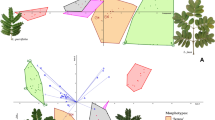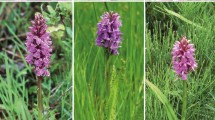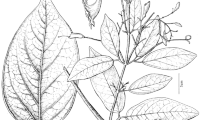Abstract
Style morph frequencies (short∶mid∶long) were determined for a total of n = 11 918 plants in 16 Minnesota populations of Lythrum salicaria L. Nine populations were in the establishment phase, with population sizes ranging from n = 56 to n = 2 192. Most of these populations exceeded previously reported population sizes in the native European habitat. A nonparametric statistical test, the chi-square (χ2), can be used to determine if populations are at isoplethic equilibrium (1∶1∶1, short∶mid∶long); a χ2 value >5.99 is significant at the 5% level. Only one established population (White Bear Lake, n = 1991, χ2 = 3.0) fitted the null hypothesis for isoplethy, although all established populations contained all three style morphs. Pooled values for these populations indicated an excess of mids and longs, with shorts being deficient. Colonizing populations had a higher percentage of mids (54%) when compared to established populations (33.7%). Short styles were almost nonexistent (8%) in colonizing populations. Five out of the seven populations lacked at least one style morph. A review of the literature reporting style morph frequencies in tristylous L. salicaria revealed that no statistical analysis for isoplethy has been performed. Darwin originally assumed that all populations would be isoplethic, possessing equal numbers of all three style morphs, but concluded, without statistical analysis, that, instead, populations were anisoplethic. Since tests for statistical deviations from the expected frequencies (1∶1∶1) have not been used, χ2 analysis was performed. Several of these populations were at isoplethic equilibrium (Nadder χsu2 = 1.7, Blelham χ2 = 1.69, Potsdam χ2 = 1.5, Vestfold χ2 = 0.4, Buskerud χ2 = 5.62, Kilchberg χ2 = 0.35, Lausanne χ2 = 3.32, Canberra χ2 = 5.29, Massachusetts χ2 = 3.13), suggesting that the general conclusion of anisoplethy in tristylous L. salicaria is inappropriate.
Similar content being viewed by others
References
Anderson NO, Ascher PD (1993) Style morph frequencies in Minnesota populations of Lythrum (Lythraceae). I. Distylous L. altum Pursh. Plant Cell Incompatibility Newsl, 25:4–9
Balogh GR, Bookhout TA (1989) Remote detection and measurement of purple loosestrife stands. Wildl Soc Bull 17:66–67
Barabe R (1951) Progress report on the eradication of purple loosestrife (Lythrum salicaria L.) in Quebec. Proceedings of the 4th Meeting, Eastern Section, National Weed Committee, Ottawa, Canada, 6–8 Nov 1950, pp 83–90
Barlow N (1913) Preliminary note on heterostylism in Oxalis and Lythrum. J Genet 3:53–65
Barlow N (1923) Inheritance of the three forms in trimorphic species. J Genet 13:133–145
Batra SWT, Schroeder D, Boldt PE, Mendl W (1986) Insects associated with purple loosestrife (Lythrum salicaria L.) in Europe. Proc Entomol Soc Wash 88:748–759
Bodmer H (1927) Beiträge zum Heterostylieproblem bei Lythrum salicaria L. Flora NF 22:306–341
Cody WJ (1978) The status of Lythrum alatum (Lythraceae) in Canada. Can Field Nat 92:74–75
Cutright NJ (1978) Purple loosestrife: beautiful exotic, or unwanted weed? Wis Nat Resources 2:26–27
Cutright NJ (1986) Regulation of purple loosestrife by states in the Midwest. Proc North Cent Weed Control Conf 41:123–125
Darwin CR (1865) On the sexual relations of the three forms of Lythrum salicaria. J Linn Soc London, Bot 8:169–196
Darwin CR (1868) On the character and hybrid-like nature of the offspring from the illegitimate unions of dimorphic and trimorphic plants. Proc Linn Soc Lond, Bot 10:393–437
Darwin CR (1895) The different forms of flowers on plants of the same species. Appleton, New York
Dulberger R (1970) Tristyly in Lythrum junceum. New Phytol 69:751–759
East EM (1927) The inheritance of heterostyly in Lythrum salicaria. Genetics 12:393–414
East EM (1932) Further observations on Lythrum salicaria. Genetics 17:327–334
Eckert CG, Barrett SCH (1989) The effect of population dynamics and life-history traits on genetic drift at style morph loci in tristylous populations. Am J Bot 76 [Suppl 6]: 146 (abstr)
Fisher RA (1935) On the selective consequences of East's (1927) theory of heterostylism in Lythrum. J Genetics 30:369–382
Fisher RA (1941) The theoretical consequences of polyploid inheritance for the mid styled form of Lythrum salicaria. Ann Eugenics 11:31–38
Fisher RA (1949) The linkage problem in a tetrasomic wild plant, Lythrum salicaria. Proceedings of the 8th International Congress of Genetics, pp 225–233
Fisher RA, Mather K (1940) Non-lethality of the Mid factor in Lythrum salicaria. Nature 146:521
Fisher RA, Mather K (1942) Polyploid inheritance in Lythrum salicaria. Nature 150:430
Fisher RA, Mather K (1943) The inheritance of style length in Lythrum salicaria. Ann Eugenics 12:1–23
Gilbert N, Lee SB (1980) Two perils of plant populations dynamics Lythrum salicaria, Canadian population, Australian population. Oecologia 46:283–284
Graham SA (1975) Taxonomy of the Lythraceae in the southeastern United States. SIDA Contrib Bot 6:80–103
Haldane JBS (1936) Some natural populations of Lythrum salicaria. J Genet 32:393–397
Halkka O, Halkka L (1974) Polymorphic balance in small island populations of Lythrum salicaria. Ann Bot Fen 11:267–270
Heuch I (1979a) The effect of partial self-fertilization on type frequencies in heterostylous plants. Ann Bot 44:611–616
Heuch I (1979b) Equilibrium populations of heterostylous plants. Theor Popul Biol 15:43–57
Heuch I (1980) Loss of incompatibility types in finite populations of the heterostylous plant Lythrum salicaria Hereditas 92:53–57
Høeg OA (1944) Om forholdstallene for de tre slags blomster av Lythrum salicaria i Norge. Blyttia 2:71–74
Koehne E (1885) The Lythraceae of the United States. Bot Gaz (Chicago) 10:268–277
Koehne E (1903) Lythraceae. In: Engler A (ed) Das Pflanzenreich. Engelmann, Leipzig 6(17): 1–78
Kuusvruori S (1960) Trimorphic heterostyly in Lythrum salicaria. Department of Genetics, University of Helsinki
Lakela O (1965) A flora of northeastern Minnesota. University of Minnesota Press, Minneapolis
Levin DA (1970) Assortative pollination in Lythrum. Am J Bot 57:1–5
Louis-Marie P (1944) La salicaire dans le Quebec. Inst Ag d'Oka, Province de Quebec
Minneapolis Park and Recreation Board (1920) Forestry Nursery Record, October 30
Minnesota Department of Natural Resources (nd) The facts about purple loosestrife. St. Paul, Minnesota
Mulcahy DL, Caporello D (1970) Pollen flow within a tristylous species: Lythrum salicaria. Am J Bot 57:1027–1030
Ornduff R (1975) Pollen flow in Lythrum junceum, a tristylous species. New Phytol 75:161–166
Ornduff R (1978) Features of pollen flow in dimorphic species of Lythrum section Euhyssopifolia. Am J Bot 65:1077–1083
Ownbey G, Morley T (1991) Vascular plants of Minnesota. University of Minnesota Press, Minneapolis
Pursh F (1814) Flora Americae Septentrionalis; or, a systematic arrangement and description of the plants of North America. White, Cochrane and Co., London
Rendall J (1989) The Lythrum story: a new chapter. Minn Hort 117:22–24
Rudkin WH (1879) Lythrum salicaria L. Bull Torrey Bot Club 6:323
Schoch-Bodmer H (1938) The proportion of long-, mid-, and short-styled plants in natural populations of Lythrum salicaria L. J Genet 36:39–43
Shamsi SR, Whitehead FH (1974) Comparative eco-physiology of Epilobium hirsutum L. and Lythrum salicaria L. I. General biology, distribution, and germination. J Ecol 62:279–290
Shinners LH (1953) Synopsis of the United States species of Lythrum (Lythraceae). Field Lab 21:80–89
Stout AB (1920) Further experimental studies on self-incompatibility in hermaphrodite plants. J Genet 9:85–129
Stuckey R (1980) Distributional history of Lythrum salicaria (purple loosestrife) in North America. Bartonia 47:3–20
Ubisch G von (1925) Genetisch-Physiologische Analyse der Heterostylie. Bibliogr Genet 2:287–340
Vaucher JPE (1841) Histoire physiologique des plantes d'Europe, tome ii. Paris, p 371
Welling CH, Becker RL (1990) Seed bank dynamics of Lythrum salicaria L.: implications for control of this species in North America. Aquat Bot 38:303–309
Woehler EE, Henderson RA (1986) Distribution of purple loosestrife in the Midwest. Proc North Central Weed Control Conf 41:129
Author information
Authors and Affiliations
Additional information
This is Scientific Journal Series Paper Number 19 128 of the Minnesota Agricultural Experiment Station
Rights and permissions
About this article
Cite this article
Anderson, N.O., Ascher, P.D. Style morph frequencies in Minnesota populations of Lythrum (Lythraceae). Sexual Plant Reprod 8, 105–112 (1995). https://doi.org/10.1007/BF00230897
Received:
Accepted:
Issue Date:
DOI: https://doi.org/10.1007/BF00230897




